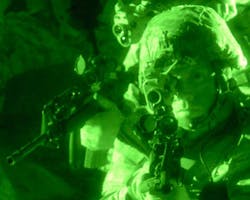Army picks DRS and BAE Systems to develop integrated night-vision goggles and weapon sights
ABERDEEN PROVING GROUND, Md., 8 May 2014. U.S. Army night vision experts are looking to two electro-optics companies to develop the next generation of military night-vision weapon sights to enable soldiers to fight effectively at night.
Officials of the Army Contracting Command at Aberdeen Proving Ground, Md., announced contracts late Tuesday to the BAE Systems Electronic Systems segment in Nashua, N.H., and the DRS Technologies Imaging and Targeting Solutions (ITS) segment in Dallas to build Individual and Enhanced Night Vision Goggle (ENVG) III weapon sights.
These weapon sights, which will be linked wirelessly to the head-worn displays in Enhanced Night Vision Goggles III, will enable solders to shoot their weapons with reasonable accuracy from behind cover without exposing their heads to enemy fire.
BAE Systems and DRS ITS also are expected to produce the head-worn goggle for the ENVG III system. The head-worn goggle and the weapon sight are tightly linked to enable the user to fight at night with the two components.
Related: U.S. military electro-optical spending to reach $13.5 billion over next 10 years
This capability also is expected to enable soldiers to shoot their rifles accurately over walls, around corners, and using other kinds of cover in difficult conditions such as urban warfare.
Compared with previous versions of the ENVG, the ENVG III weapon sights also will have improved resolution and a wider field of view. Exelis Night Vision Systems in Roanoke, Va., and L-3 Warrior Systems in Londonderry, N.H., are producing the ENVG II. The ENVG III acquisition combines the system's goggle with its Family of Weapon Sights-Individual (FWS-I). The ENVG III is a follow-on contract to previous ENVG I and ENVG II procurements.
The distinction of ENVG III from previous ENVGs is the added rapid target acquisition technology when used with the FWS-I, which is to be a weapon-mounted long-wave infrared sensor used for surveillance and aiming weapons during daylight, darkness, adverse weather, and dirty battlefield conditions, Army officials say.
When combined with the ENVG III, the FWS-I provides rapid target acquisition which wirelessly will send weapon imagery from the sight to the night-vision goggle eyepiece spatially aligned with the ENVG III image.
The rapid target acquisition capability is expected to cut in half the time a soldier typically takes to detect and shoot at a target. This will improve soldier lethality, enhance soldier effectiveness and improve soldier survivability by reducing soldier exposure to threat weapons, Army officials say.
For this contract, BAE Systems and DRS ITS will compete for separate Army orders over the next five years. For more information contact BAE Systems Electronic Systems online at www.baesystems.com, or DRS ITS at www.drs.com.

